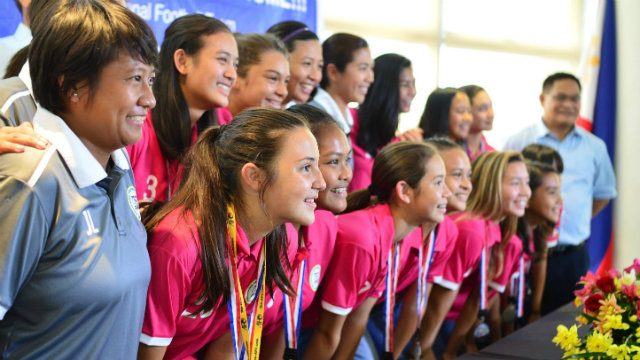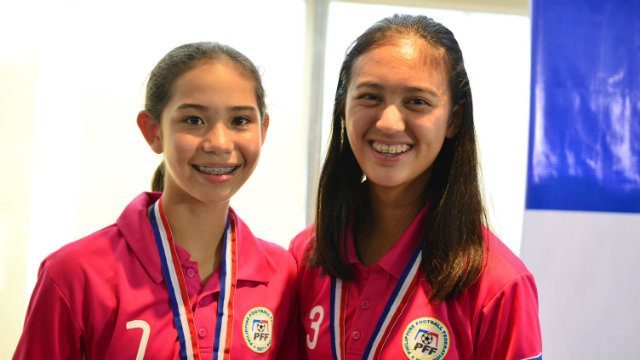SUMMARY
This is AI generated summarization, which may have errors. For context, always refer to the full article.

By any measure, the Philippine Girls U14 national football team has done us proud in finishing runner-up to Thailand in the 2016 Asian Football Confederation regional championship last week. The feat echoes that of coach Let Dimzon’s 2014 side that also placed second to the Thais. That team featured Davao’s Joyce Semacio as the competition MVP.
At Tuesday’s press conference in the PFF office, there were plenty of stories about all the obstacles the squad faced along the way. Just before the tournament, a key player was lost to an ACL injury. Also, one of the goalkeepers had a passport issue and couldn’t make the squad. Striker Arianna Lepage was forced to take the gloves and be listed as a keeper, thereby rendering her ineligible to be an outfield player.
The Philippines only dressed 16 players for each game, two less than other teams.
The matches, 70 minutes long, were also clustered in a short span of time, with the semifinal and final conducted on consecutive days.
Despite the difficulties, the Pinays had a terrific tournament, defeating the hosts Laos 3-1 in the opener, then drawing Thailand 2-2 with a dramatic 76th minute stoppage-time equalizer from Katelyn Alexander.
A subsequent 1-0 group win over Cambodia put them in the semifinals against Myanmar. That was the finest performance for coach Joyce Landagan’s squad. With the score knotted at 1-1 at the half, Carleigh Frilles went berserk with a second-half hat trick to lead the Philippines to a 5-1 rout. The magic ran out last Sunday as the Thais prevailed 1-0 in the final.
Surely one of the factors in this success was the presence of outstanding Filipina players from the USA and Canada in this team. Twelve of them came to the Philippines for tryouts, 8 were selected for the final squad, 7 flew to Laos. Assistant coach Belay Fernando said the overseas-born Filipinos had no special treatment in the selection process and were picked purely on merit.
What makes these players so good? I spoke with one of them to find out.

Trinity Wambolt is the daughter of a Filipina mother from Quezon City named Bernadette. Wambolt began playing soccer in Toronto, Canada 5 years ago at age 9. She said she played for 3 years in the North Mississauga Soccer Club. (Mississauga lies southwest of Toronto.)
She trained 3 times a week and had a competitive game every weekend, all-year round. The club fended off the brutal Ontario winters by playing indoors in an artificial-grass venue when the weather got too chilly.
Wambolt said all her competitive matches were 9-a-side games with offside. Occasionally they would also play in a futsal (5-a-side indoor soccer), league. The only time she would play 7-a-side would be with her school team, once or twice a year.
So by the age of 13, Wambolt, if we count 40 weekends a year with some breaks, had about 120 competitive matches of experience under her belt. Plus, those games were all under the tutelage of a CONCACAF “B” license coach. (Each match was 60 minutes long.)
Wambolt is now with another team, Epic FC, an organization that seems to have lofty ambitions. The club website, describes Epic as “a high performance soccer program with the focus on bringing the best talent [in] the Great Toronto Area together with top-level coaching and exposing it [to the] highest levels of youth international soccer.”
According to Wambolt, Epic has on its roster 3 members of the Canadian national U15 girls team. For sure, she is getting top-notch training in her new club, and this is the result: watch the video of one of the two goals the central midfielder scored in the campaign. (She also had one assist.)
PWNT U14s winning goal! #PilipinasU14 #LABANFILIPINAS #AFCU14Girls #AFCCup2016 pic.twitter.com/i5DGc2QM3b
— Anthony Collatos (@CollatosAnthony) June 2, 2016
I hoped to contrast Wambolt’s development with that of one of her national team assistant coaches, Marielle Benitez. So I asked Benitez in the press conference what her training and competitive experience was at that age. She couldn’t give an answer. Benitez only began playing football at the age of 13 in Paref-Woodrose school.
Coach Marielle, who went on to captain the women’s senior national team, said that although she trained 3 times a week at that age, most of her formative career in football was spent playing 7s football, (presumably sans the offside rule,) with the now-defunct Metro Manila Girls Football Association league. There were some 11-a-side tournaments, but she said she only participated in a bit less than 20 11s matches in one year. It’s only when Benitez played for DLSU that the full-sized game became her bread-and-butter.
They say Marielle was a terrific player when she was with the national side. But how good would she have been with the kind of training and support Wambolt got from an early age? Who knows? Maybe she could have played professionally abroad.
There would be many changes needed to consistently churn out players of Wambolt’s caliber in the Philippines. But the two biggest might be an increase in competitions, specifically 9 and 11-a-side ones for girls, and improved coaching. Can it be done? Why not? Philippine women’s football certainly has the momentum.
Benitez said today’s Filipina footballers have better educated coaches and more tactical know-how. “There’s more football on TV now, so more avenues to learn.”
Benitez also added that in her day, there was no U14 girls national team, (the closest thing was the Gothia Cup in Sweden,) just the senior side. In fact, she was first selected for the senior squad at 16. The Philippines recently competed in U19 international tournaments as well.
Filipina football is also powering through in other aspects, notably on the coaching side. Senior NT coach Buda Bautista is taking the tough AFC Pro Diploma course, the highest level of coaching accreditation offered by the confederation. Dimzon topped a FIFA coaching course in Germany two years ago, shortly after she led the U14s to the silver in this competition with a mostly homegrown team. Fernando, Benitez, and another assistant, Patrice Impelido, all former national team players, all have AFC “C” license badges. One would assume they will take the “B” exam sooner or later.
There is an entity called Pinay Futbol that is actively promoting the women’s game on social media. Mia Montayre of Pinay Futbol was at the press conference, dressed in one of the organization’s distinctive electric blue shirts.
It has been rumored that the Philippine NCAA is considering adding a women’s football division. That would add more female university-level teams to augment the 5 in UAAP.
Pinay football players have more competitions than ever. The UFL’s youth competition has a 5-team U17 girls division, RIFA (Rizal Football Association), has girls tournaments, and the PSC has hosted girls’ events too. (Although the one scheduled last summer was scrapped due to scheduling issues with Rizal Memorial.)
The first season of the Metro Manila Futsal League recently concluded, and girls played alongside boys in the two youth categories.
Women’s football also has a very powerful patron in Senator Pia Cayetano, who has conducted grassroots 3-on-3 football events for girls in different parts of the country. She also supports the women’s football team of her alma mater, UP.
The senior women’s team, under Bautista, will join the Asean Football Federation championship in Myanmar in July.
So the U14 girls’ podium finish is really just another part of an encouraging trend. One that could lead us to greater glory one day, if we play our cards right. Marielle Benitez certainly thinks we have the right to dream.
“I don’t think it’s too far off to see the Philippines in the Women’s World Cup one day.” – Rappler.com
Follow Bob on Twitter @PassionateFanPH. Follow @PinayFutbol as well.
Add a comment
How does this make you feel?
There are no comments yet. Add your comment to start the conversation.